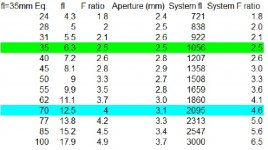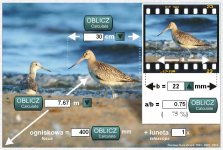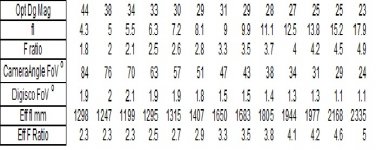1) effective focal length (focal length of the camera lens - scope combination)
f = 4.3 mm (focal length of the camera lens, minimal focal length 4.3 mm instead of 6.3 mm)
m = 25-75× (magnification)
f' = f * m
m = 25 → f' = 4.3 * 25 = 107.5 mm
m = 75 → f' = 4.3 * 75 = 322.5 mm
2) crop factor
1/2.3" sensor:
diagonal = 7.70 mm
width = 6.16 mm
height = 4.62 mm
crop factor = 5.62
http://en.wikipedia.org/wiki/Image_sensor_format
d = √(6.16^2 + 4.62^2) = 7.70 mm (diagonal calculated)
35 mm film:
d0 = √(24^2 + 36^2) = 43.27 mm (diagonal)
Crop Factor
FLM = d0 / d = 43.27 / 7.70 = 5.62 (Crop Factor calculated)
3) focal length equivalent for 35 mm film
EFL = f' * FLM
m = 25 → EFL = 107.5 mm * 5.62 = 604.15 mm
m = 75 → EFL = 322.5 mm * 5.62 =
1812.45 mm
------------------------------------------------------
You can also compute focal length equivalent for the camera lens alone:
4.3 mm * 5.62 = 24.166 mm
and later for the camera lens - scope combination:
m = 25 → EFL = 24.166 mm * 25 = 604.15 mm
m = 75 → EFL = 24.166 mm * 75 =
1812.45 mm
------------------------------------------------------
You can perform calculations using this calculator:
JavaScript Calculator
This one can calculate relation between focal length, object distance, object size, sensor dimensions, image size and scope magnification:
http://darekk.com/kalkulator/






